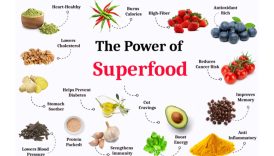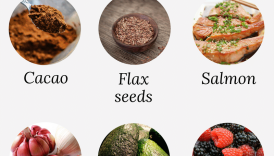From Farm to Table: How to Incorporate Fresh Ingredients Into Your Diet

The Importance of Fresh Ingredients
In today’s fast-paced world, the push for convenience often overshadows the joys of cooking with fresh ingredients. However, incorporating fresh produce and other natural components into meals is essential for both health and flavor. When shopping for groceries, the vibrant colors of fresh fruits and vegetables not only attract the eyes but also signal nutritional wealth. Why choose fresh ingredients? Here are a few compelling reasons:
- From Farm to Table: How to Incorporate Fresh Ingredients Into Your Diet
- The Importance of Fresh Ingredients
- Benefits of Incorporating Fresh Ingredients
- Improved Nutrition
- Better Flavor Profiles
- Shopping for Fresh Ingredients
- Local Farmer's Markets
- Organic Grocery Stores
- Seasonal Eating
- Spring
- Summer
- Fall
- Meal Planning with Fresh Ingredients
- Breakfast Options
- Lunch and Dinner Ideas
- Cooking Techniques to Preserve Freshness
- Raw Dishes
- Lightly Cooked Recipes
- Food Safety Tips
- Proper Storage Practices
- Avoiding Cross-Contamination
- Growing Your Own Ingredients
- Indoor Herb Gardens
- Container Gardening
- Community Supported Agriculture (CSA)
- How CSA Works
- Benefits of Joining a CSA Program
- Nutritional Benefits: Fresh food has higher vitamin and mineral content compared to processed counterparts.
- Flavor Explosion: The difference in taste is undeniable; fresh ingredients enhance the overall dining experience, making every meal exciting.
- Supporting Local Farmers: Purchasing local produce contributes to the community and often ensures you’re getting the best quality.
For example, consider cooking a simple salad. Using fresh, locally sourced tomatoes and crisp lettuce yields a salad bursting with flavors compared to one made from canned ingredients. Embracing fresh ingredients can transform everyday meals into extraordinary culinary experiences.
Benefits of Incorporating Fresh Ingredients
Improved Nutrition
When it comes to health, the benefits of fresh ingredients cannot be overstated. Eating fresh produce, such as fruits and vegetables, provides essential vitamins, minerals, and antioxidants that are vital for overall well-being. Unlike processed foods, which often contain added sugars and unhealthy fats, fresh ingredients offer a nutrient-packed punch. For example:
- Vitamins galore: Fresh fruits like oranges and blueberries are rich in vitamins C and K.
- Fiber-rich foods: Vegetables such as spinach and broccoli are excellent sources of dietary fiber, promoting digestive health.
Incorporating more fresh ingredients into meals can lead to lasting positive changes in your nutritional habits, helping to reduce the risk of chronic disease.
Better Flavor Profiles
In addition to nutritional advantages, fresh ingredients drastically elevate meal flavors. Imagine biting into a sun-ripened tomato versus one from a can – the difference is astonishing. Fresh herbs, too, add a depth of flavor that dried alternatives simply cannot replicate. Here are a few flavor-enhancing benefits of fresh ingredients:
- Vibrant Colors: Bright produce often indicates robust flavor and ripeness.
- Natural Sweetness: Fresh fruits can provide the perfect, unprocessed sweetness in desserts.
Choosing fresh means not just healthier meals, but richer, more satisfying eating experiences that keep taste buds excited!
Shopping for Fresh Ingredients
Local Farmer’s Markets
After understanding the benefits of fresh ingredients, let’s explore where to find them. Local farmer’s markets are a treasure trove for anyone looking to enjoy fresh produce straight from the source. These markets not only provide high-quality fruits and vegetables, but they also foster a sense of community. I remember my first visit to a farmer’s market; the enthusiasm of the vendors, the vibrant displays of colorful veggies, and the aroma of freshly baked bread was an experience to cherish.
- Seasonal Selection: You’ll find produce at its peak freshness, often picked within hours of being sold.
- Support Local Farms: Purchasing here supports local farmers, ensuring they can continue sustainable practices.
Organic Grocery Stores
If farmer’s markets are a bit challenging to access, organic grocery stores serve as a fantastic alternative. These stores typically have dedicated sections for fresh, organic produce. Shopping here allows you to easily select items that are not only fresh but also free from harmful pesticides.
- Wide Variety: From exotic fruits to unique herbs, the options in organic grocery stores are often impressive.
- Quality Assurance: Organic certification often guarantees higher standards for freshness and sustainability.
By choosing either alternative, you can ensure that your pantry is stocked with the freshest ingredients available!
Seasonal Eating
Spring
As we embrace seasonal eating, each season brings a unique bounty of fresh ingredients that can enhance our meals. Spring is a time of renewal, and the market overflows with vibrant, tender produce. Think of fresh asparagus, peas, and radishes! Having made a light salad loaded with these, I vividly remember the crunch and sweetness bursting with each bite.
- Spring Produce Highlights:
- Asparagus
- Peas
- Strawberries
Summer
Then comes summer, the season of abundance! With warm weather, gardens yield juicy tomatoes, crisp cucumbers, and sweet corn. Summer is perfect for barbecues and picnics. I still recall a delightful summer gathering with friends, where fresh caprese salad made with ripe tomatoes and basil stole the show.
- Summer Favorites:
- Tomatoes
- Sweet corn
- Zucchini
Fall
As fall approaches, we transition into heartier fare. This season introduces us to squash varieties, apples, and root vegetables. Making a fragrant pumpkin soup became a cozy tradition of mine, thanks to the rich flavors of freshly harvested squash.
- Fall Essentials:
- Pumpkins
- Apples
- Sweet potatoes
Embracing seasonal eating not only maximizes flavor but also connects us to the earth’s natural cycles, making every meal an opportunity for culinary delight!
Meal Planning with Fresh Ingredients
Breakfast Options
Now that we’ve explored the essence of seasonal eating, let’s dive into practical meal planning using fresh ingredients. Breakfast is often seen as the most important meal of the day, and it can be a delightful way to kickstart your morning! Personalizing your breakfast with fresh fruits and vegetables not only nourishes your body but also energizes your spirit. A quick smoothie with seasonal berries and spinach is a favorite go-to of mine – it’s refreshing and easy. Here are some fresh breakfast ideas:
- Overnight oats topped with sliced bananas and walnuts.
- Avocado toast garnished with heirloom tomatoes and a sprinkle of salt.
- Egg scrambles loaded with spinach, peppers, and onions.
Lunch and Dinner Ideas
For lunch and dinner, fresh ingredients pave the way for creativity. I love whipping up a colorful summer salad with greens, cherry tomatoes, cucumbers, and a dash of olive oil. When it comes to heartier meals, consider these options:
- Grilled vegetable skewers paired with quinoa.
- Zucchini noodles tossed with a homemade pesto sauce.
- Stuffed bell peppers filled with brown rice and vegetables.
Meal planning with fresh ingredients not only simplifies grocery shopping but also invites a world of flavors and health benefits to our daily meals!
Cooking Techniques to Preserve Freshness
Raw Dishes
As we continue our journey through meal planning, it’s essential to know how to preserve the freshness of ingredients through thoughtful cooking techniques. One effective way is to incorporate raw dishes into your meals. Not only are they quick to prepare, but they also maintain the vibrant nutrients found in fresh produce. One of my favorites is a refreshing salad made with crisp lettuce, grated carrots, and juicy cherry tomatoes, dressed with a simple lemon vinaigrette—it’s a burst of flavor and nutrition in every bite. Consider these easy raw dish ideas:
- Zucchini noodles tossed with a raw tomato sauce.
- Gazpacho, a chilled soup made with fresh tomatoes, cucumbers, and bell peppers.
- Fruit salads that mix seasonal fruits for an invigorating side.
Lightly Cooked Recipes
On the other hand, lightly cooked recipes can also help preserve the freshness while enhancing flavors. Quick steaming or sautéing allows vegetables to remain crisp yet tender. I often quickly sauté asparagus and snap peas with garlic, and the result is bright green veggies that still pack a crunchy texture. Some lightly cooked ideas include:
- Stir-fried greens with ginger and sesame.
- Blanched broccoli served with a drizzle of olive oil and lemon.
- Roasted sweet potatoes seasoned with a hint of cinnamon.
Using these techniques, one can enjoy the essence of fresh ingredients while crafting meals that are both delicious and nutritious!
Food Safety Tips
Proper Storage Practices
With all these delightful dishes in mind, let’s ensure we keep our ingredients fresh and safe with some essential food safety tips. Proper storage practices can significantly extend the life of your fresh ingredients. I’ve learned the hard way how crucial it is to store produce correctly after discovering wilted greens hidden in my refrigerator! Here are some effective storage tips:
- Keep veggies crisp: Store leafy greens in breathable containers lined with damp paper towels to retain moisture.
- Fruit care: Place fruits in the crisper drawer, but remember to keep apples separate from other fruits as they emit ethylene gas, which can accelerate ripening.
- Seal leftovers: Use airtight containers for any leftovers, ensuring they maintain freshness while preventing contamination.
Avoiding Cross-Contamination
In addition to proper storage, avoiding cross-contamination in the kitchen is vital for food safety. Mixing raw meats with fresh produce can lead to foodborne illnesses—something no one wants to encounter! I always designate cutting boards and utensils for specific foods to minimize risk. Consider these best practices:
- Separate utensils: Use different cutting boards for meats and vegetables.
- Wash hands frequently: Ensure hands, surfaces, and utensils are washed with soap after handling raw ingredients.
- Store wisely: Place raw meats on the bottom shelf of the fridge to prevent juices from dripping onto other foods.
By incorporating these food safety tips into your routine, you can enjoy fresh ingredients confidently and deliciously!
Growing Your Own Ingredients
Indoor Herb Gardens
As we explore the joys of cooking with fresh ingredients, what could be better than growing your own? Cultivating an indoor herb garden is an amazing way to add flavor to your meals while ensuring your ingredients are completely fresh. I still remember the first time I snipped fresh basil for a homemade pasta dish; the aroma filled my kitchen and made the meal extra special! To set up your indoor herb garden, consider these tips:
- Choose the right herbs: Basil, parsley, and cilantro are easy to grow and amplify many dishes’ flavors.
- Optimal lighting: Place your herbs near a sunny window or use grow lights to ensure they get enough sunlight.
- Regular watering: Keep the soil moist but not soggy—overwatering can lead to root rot.
Container Gardening
If you have a little outdoor space, container gardening expands your growing options even further. Whether it’s on a balcony or a small patio, you can grow a variety of vegetables and herbs in pots. It was inspiring to see how tomatoes flourished in my pots last summer, and the taste was simply unbeatable! Here are a few container gardening tips to get you started:
- Choose the right containers: Ensure pots have proper drainage holes and are large enough for root growth.
- Select high-quality soil: Using nutrient-rich potting soil helps your plants thrive.
- Rotate crops: To keep soil healthy, rotate your crops each season and incorporate companion planting.
By growing your own ingredients, you not only gain access to fresh flavors but also connect personally with the food you create!
Community Supported Agriculture (CSA)
How CSA Works
As we delve deeper into the world of fresh ingredients, Community Supported Agriculture (CSA) programs are a fantastic way to access seasonal produce while supporting local farmers. Here’s how it typically works: when you join a CSA, you purchase a share in a local farm at the beginning of the growing season. In return, you receive weekly or biweekly boxes filled with a delicious assortment of what’s fresh and in season.
- Commitment to the farm: Members commit upfront, which helps farmers with planning and growing.
- Variety in your box: Each delivery varies based on what’s being harvested, introducing you to new vegetables and fruits.
Benefits of Joining a CSA Program
Joining a CSA program comes with numerous benefits that extend beyond just receiving fresh produce. I remember my first box arrived brimming with rainbow chard, heirloom tomatoes, and aromatic herbs; it inspired a culinary adventure! Here are some benefits to consider:
- Seasonal eating: Enjoying what’s in season enhances flavor and nutritional value.
- Support local agriculture: Directly contribute to your community’s farming economy.
- Discover new foods: You’ll often receive unfamiliar items, encouraging culinary creativity in the kitchen.
By participating in a CSA program, not only do you eat healthier, but you also forge a deeper connection with your food and local farmers!





